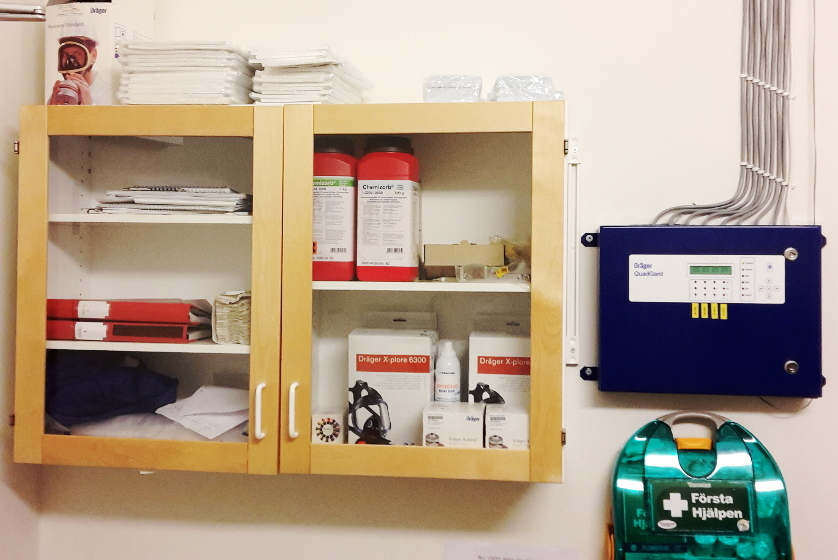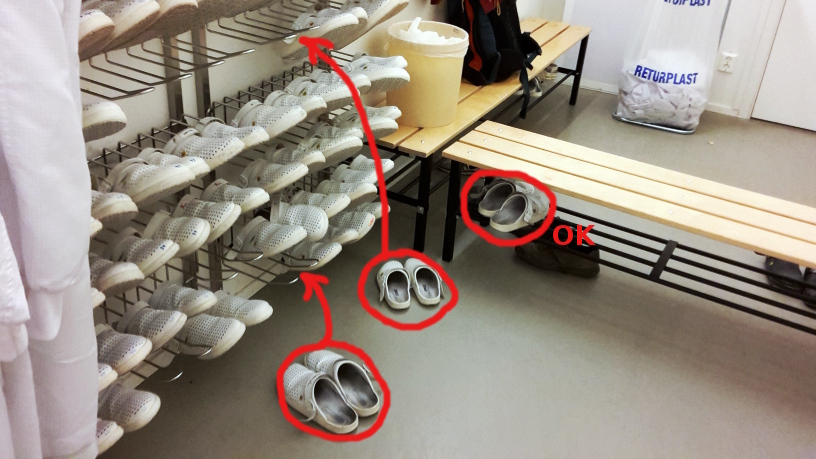Cabinet with safety material, gas alarm and wall mounted First Aid Kit


There is a wall mounted cabinet immediately to the left when you get into the entrance to the clean room. It contains gas masks with separate filters in the case of a leak of corrosive gases (Cl2 or BCl3). The cabinet also contains absorbing material for spillage of liquid chemicals, both powder and granulate.
There are also two containers of "Diphoterine", to help if chemicals get on the skin or in the eyes.
There are two binders with Material Safety Data Sheets (MSDS). However, the complete collection is in the office of the lab manager.
To the right is the alarm central for the gas sensors. If there is a gas leak, there will sound an alarm here and a red alarm lamp will blink inside the process lab.
Below the alarm central is a wall mounted first aid kit containing band aid, compresses, bandages, etc. This kit can easily be taken away from the wall mount and taken into the lab in an emergency.

|
|
The clean-room
shoes should always be placed on the racks. Never leave the
shoes on the floor when you leave the lab.
For a short visit outside of the lab (e.g. nature calls) it is OK to leave the coat, hair-protection and shoes on the bench. (Please note that this is NOT an arranged picture). |
The clean air benches have an air intake at the front, that is the perforated part at the front edge of the bench. Please do NOT block this area by putting wipes etc. on it. This will reduce the clean air flow, and will destroy the cleanliness inside the bench.
The idea with this front intake of air is that it shall act as a barrier against particles entering the inner of the work area. The filtered air is coming from above via a HEPA-filter in the ceiling of the bench.
The fume hood does not provide filtered clean air, it only have constant under-pressure relative to the room in order to remove harmful fumes.
Please remember to always push down the front glass panel to its lowest position when you are not using it. When the front panel is at the lowest position the internal light is turned off.
This is important for the air-balance in the lab, there is a slight over-pressure in the lab relative to the corridors outside. This is so because the dirty air outside the lab should not be coming in.
This over-pressure is reduced the more the fume hood is open, thus causing more particles from outside the lab entering into it.
Keep the inside of the fume hood clean from bottles, beakers etc., just like in the picture above.
If the fume hood front is raised over the maximum marks the evacuation
of fumes does no longer work.
Also the over-pressure in the rest of the
lab is very much reduced, it might also become an under-pressure, thereby
causing dirty air from outside to be sucked into the lab.
Please always wash up your used glass-ware. Put it do dry by hanging it on the pins or on the dish-shelf. Try to avoid putting it on the sink on clean wipes. The space is small even without this.
Dry glass-ware should be put back in the cabinet storing glass-ware.
In order to extend life-time of microscope lamps, please turn them off when you are done.
There is a cleaning of the labs every other week. Then the wastebaskets are emptied. This is not always enough. If you see an overfull wastebasket, please take out the bag, close it by a knot and bring it outside the lab, outside of the entrance. There should be a new bag on the bottom of the wastebasket.